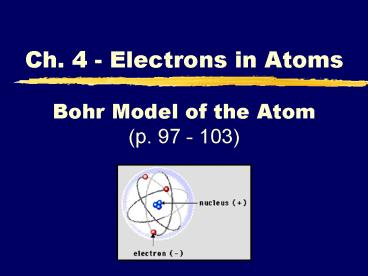Bohr Model of the Atom p. 97 103 - PowerPoint PPT Presentation
1 / 14
Title:
Bohr Model of the Atom p. 97 103
Description:
4 - Electrons in Atoms. A. EM Spectrum. c = c: speed of light (3.00 108 m/s) ... 'wave-particle duality' Photon - particle of light that carries a quantum of energy ... – PowerPoint PPT presentation
Number of Views:314
Avg rating:3.0/5.0
Title: Bohr Model of the Atom p. 97 103
1
Bohr Model of the Atom(p. 97 - 103)
- Ch. 4 - Electrons in Atoms
2
A. EM Spectrum
c ??
c speed of light (3.00 ? 108 m/s) ? wavelength
(m, nm, etc.) ? frequency (Hz)
3
B. Quantum Theory
- Planck (1900)
- Observed - emission of specific colors of light
from hot objects - Concluded - energy is emitted in small, specific
amounts (quanta)
- Quantum - minimum amount of energy that can be
lost or gained by an atom.
4
B. Quantum Theory
- Planck (1900)
vs.
5
B. Quantum Theory
- Einstein (1905)
- Observed - photoelectric effect
6
B. Quantum Theory
- Einstein (1905)
- Concluded - light has properties of both waves
and particles - wave-particle duality
- Photon - particle of light that carries a quantum
of energy
7
B. Quantum Theory
- The energy of a photon is proportional to its
frequency.
E h?
- E energy (J, joules)
- h Plancks constant (6.626 ? 10-34 J/Hz)
- ? frequency (Hz)
8
C. Line-Emission Spectrum
excited state
ENERGY IN
PHOTON OUT
ground state
9
D. Bohr Model
- e- exist only in orbits with specific amounts of
energy called energy levels - Therefore
- e- can only gain or lose certain amounts of
energy (quanta) - only certain photons are produced
10
D. Bohr Model
- Energy of photon depends on the difference in
energy levels - Bohrs calculated energies matched the IR,
visible, and UV lines for the H atom
6
5
4
3
2
1
11
D. Other Elements
- Each element has a unique bright-line emission
spectrum. - Atomic Fingerprint
Helium
- Bohrs calculations only worked for hydrogen! ?
12
E. Examples
- EX 1 Find the frequency of a photon with a
wavelength of 434 nm.
GIVEN ? ? ? 434 nm 4.34 ? 10-7 m c
3.00 ? 108 m/s
? 6.91 ? 1014 Hz
13
E. Examples
- EX 2 Find the energy of a red photon with a
frequency of 4.57 ? 1014 Hz.
GIVEN E ? ? 4.57 ? 1014 Hz h 6.626 ? 10-34
J/Hz
WORK E h? E (6.626 ? 10-34 J/Hz) (4.57 ?
1014 Hz) E 3.03 ? 10-19 J
14
E. Examples
- EX 3 Find the energy of a photon whose
wavelength is 1.0 ? 10-9 m.
- GIVEN
- E ?
- 1.0 ? 10-9 m
- c 3.00 ? 108 m/s
- h 6.626 ? 10-34 Js
WORK E h? hc/ ? ? (6.626 10-34 J/Hz)(3.00
108 m/s) 1.0 x 10-9 J E 2.0 ? 10-16 J































